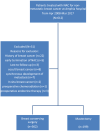Disease-free and overall survival after neoadjuvant chemotherapy in breast cancer: breast-conserving surgery compared to mastectomy in a large single-centre cohort study
- PMID: 33073303
- PMCID: PMC7867515
- DOI: 10.1007/s10549-020-05966-y
Disease-free and overall survival after neoadjuvant chemotherapy in breast cancer: breast-conserving surgery compared to mastectomy in a large single-centre cohort study
Abstract
Purpose: The extended role of breast-conserving surgery (BCS) in the neoadjuvant setting may raise concerns on the oncologic safety of BCS compared to mastectomy. This study compared long-term outcomes after neoadjuvant chemotherapy (NAC) between patients treated with BCS and mastectomy.
Methods: All breast cancer patients treated with NAC from 2008 until 2017 at the Amphia Hospital (the Netherlands) were included. Disease-free and overall survival were compared between BCS and mastectomy with survival functions. Multivariable Cox proportional hazard regression was performed to determine prognostic variables for disease-free survival.
Results: 561 of 612 patients treated with NAC were eligible: 362 (64.5%) with BCS and 199 (35.5%) with mastectomy. Median follow-up was 6.8 years (0.9-11.9). Mastectomy patients had larger tumours and more frequently node-positive or lobular cancer. Unadjusted five-year disease-free survival was 90.9% for BCS versus 82.9% for mastectomy (p = .004). Unadjusted five-year overall survival was 95.3% and 85.9% (p < .001), respectively. In multivariable analysis, clinical T4 (cT4) (HR 3.336, 95% CI 1.214-9.165, p = .019) and triple negative disease (HR 5.946, 95% CI 2.703-13.081, p < .001) were negative predictors and pathologic complete response of the breast (HR 0.467, 95% CI 0.238-0.918, p = .027) and axilla (HR 0.332, 95% CI 0.193-0.572, p = .001) were positive predictors for disease-free survival. Mastectomy versus BCS was not a significant predictor for disease-free survival when adjusted for the former variables (unadjusted HR 2.13 (95%CI: 1.4-3.24), adjusted HR 1.31 (95%CI: 0.81-2.13)). In the BCS group, disease-free and overall survival did not differ significantly between cT1, cT2 or cT3 tumours.
Conclusion: BCS does not impair disease-free and overall survival in patients treated with NAC. Tumour biology and treatment response are significant prognostic indicators.
Keywords: Breast cancer; Breast-conserving surgery; Lumpectomy; Mastectomy; Neoadjuvant chemotherapy; Survival.
Conflict of interest statement
All authors declare that they have no conflicts of interest.
Figures




Similar articles
-
Oncological outcomes of breast-conserving surgery versus mastectomy following neoadjuvant chemotherapy in a contemporary multicenter cohort.Sci Rep. 2025 Mar 16;15(1):9032. doi: 10.1038/s41598-025-93491-7. Sci Rep. 2025. PMID: 40091103 Free PMC article.
-
Breast surgery after neoadjuvant chemotherapy in patients with lobular carcinoma: surgical and oncologic outcome.Breast Cancer Res Treat. 2024 Apr;204(3):497-507. doi: 10.1007/s10549-023-07192-8. Epub 2024 Jan 8. Breast Cancer Res Treat. 2024. PMID: 38189904
-
Breast conserving therapy after neoadjuvant chemotherapy; data from the Dutch Breast Cancer Audit.Eur J Surg Oncol. 2019 Feb;45(2):110-117. doi: 10.1016/j.ejso.2018.09.027. Epub 2018 Oct 17. Eur J Surg Oncol. 2019. PMID: 30348601
-
Breast Conserving Surgery Compared With Mastectomy in Male Breast Cancer: A Brief Systematic Review.Clin Breast Cancer. 2020 Jun;20(3):e309-e314. doi: 10.1016/j.clbc.2019.12.004. Epub 2019 Dec 19. Clin Breast Cancer. 2020. PMID: 32171701 Free PMC article.
-
Breast surgery after neoadjuvant systemic therapy.Transl Breast Cancer Res. 2024 Mar 4;5:13. doi: 10.21037/tbcr-23-50. eCollection 2024. Transl Breast Cancer Res. 2024. PMID: 38751679 Free PMC article. Review.
Cited by
-
Neoadjuvant therapy with doxorubicin-cyclophosphamide followed by weekly paclitaxel in early breast cancer: a retrospective analysis of 200 consecutive patients treated in a single center with a median follow-up of 9.5 years.Breast Cancer Res Treat. 2022 Jun;193(3):597-612. doi: 10.1007/s10549-022-06598-0. Epub 2022 Apr 22. Breast Cancer Res Treat. 2022. PMID: 35451732
-
Breast-conserving surgery versus mastectomy for treatment of breast cancer after neoadjuvant chemotherapy.Front Oncol. 2023 Jul 11;13:1178230. doi: 10.3389/fonc.2023.1178230. eCollection 2023. Front Oncol. 2023. PMID: 37496664 Free PMC article.
-
Locoregional recurrence and survival of breast-conserving surgery compared to mastectomy following neoadjuvant chemotherapy in operable breast cancer.Front Oncol. 2024 Mar 28;14:1308343. doi: 10.3389/fonc.2024.1308343. eCollection 2024. Front Oncol. 2024. PMID: 38606101 Free PMC article.
-
Surgical options of the breast and clinical outcomes of breast cancer patients after neoadjuvant chemotherapy: A single-center retrospective study.Front Oncol. 2022 Oct 27;12:984587. doi: 10.3389/fonc.2022.984587. eCollection 2022. Front Oncol. 2022. PMID: 36387082 Free PMC article.
-
Innovative Standards in Surgery of the Breast after Neoadjuvant Systemic Therapy.Breast Care (Basel). 2021 Dec;16(6):590-597. doi: 10.1159/000520051. Epub 2021 Nov 2. Breast Care (Basel). 2021. PMID: 35087362 Free PMC article. Review.
References
-
- Straver ME, van Adrichem JC, Rutgers EJ, Rodenhuis S, Linn SC, Loo CE, Gilhuijs KG, Oldenburg HS, Wesseling J, Russell NS, Antonini N, Vrancken Peeters MT. Neoadjuvant systemic therapy in patients with operable primary breast cancer: more benefits than breast-conserving therapy. Ned Tijdschr Geneeskd. 2008;152(46):2519–2525. - PubMed
-
- Gobardhan PD, de Wall LL, van der Laan L, ten Tije AJ, van der Meer DC, Tetteroo E, Poortmans PM, Luiten EJ. The role of radioactive iodine-125 seed localization in breast-conserving therapy following neoadjuvant chemotherapy. Ann Oncol. 2013;24(3):668–673. doi: 10.1093/annonc/mds475. - DOI - PubMed
-
- Fisher B, Anderson S, Bryant J, Margolese RG, Deutsch M, Fisher ER, Jeong JH, Wolmark N. Twenty-year follow-up of a randomized trial comparing total mastectomy, lumpectomy, and lumpectomy plus irradiation for the treatment of invasive breast cancer. N Engl J Med. 2002;347(16):1233–1241. doi: 10.1056/NEJMoa022152. - DOI - PubMed
MeSH terms
LinkOut - more resources
Full Text Sources
Medical

